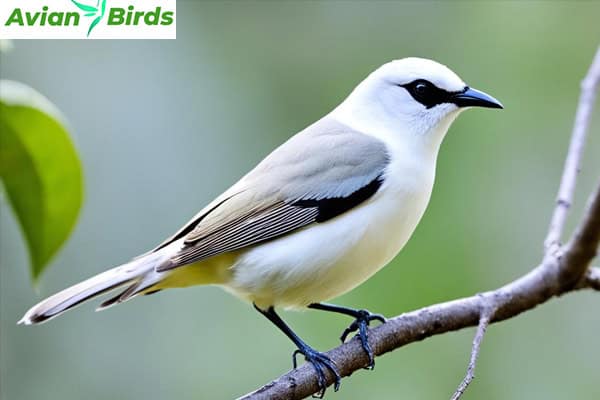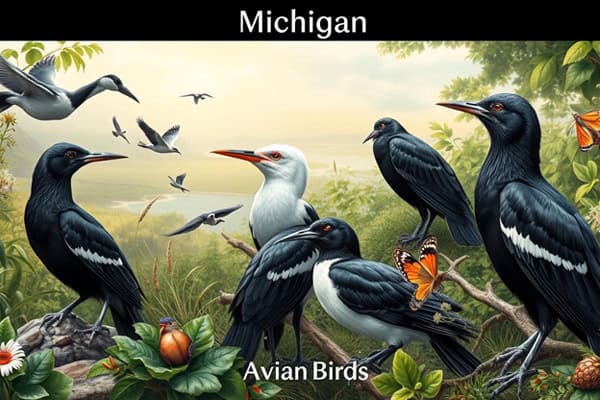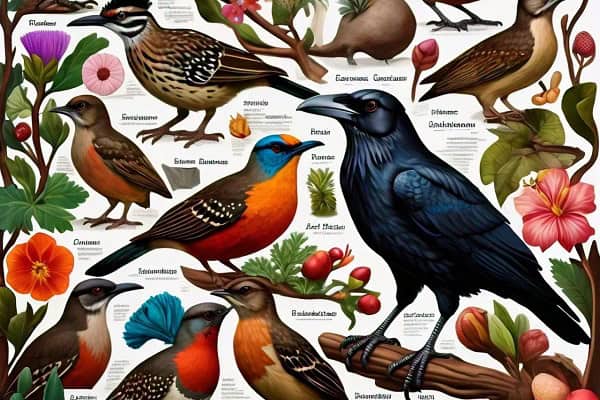White Bellbird: Loudest Bird in the Americas
Did you know the White Bellbird, known as Procnias albums, can make a sound as loud as 125 decibels? That’s as loud as a jet plane taking off! This bird, found in Central and South America, is known for its incredible vocal skills.
Its loud song is part of its unique mating rituals and behaviors. These have caught the attention of researchers and bird lovers. The White Bellbird is not just loud; it’s also fascinating to study.
Let’s explore more about the White Bellbird. You’ll learn about its amazing traits, where it lives, and its importance in nature. Get ready to be amazed by the loudest bird in the Americas!
~Here we’ll learn about the White Bellbird (The Loudest Bird)~
Fun Facts:
- Scientific Name: Procnias albus
- Weight: Approximately 250 grams
- Length: Roughly 28 centimeters
- Age: Not well-documented
- Diet: Primarily fruit, typically consumed whole
Introduction to the White Bellbird
The White Bellbird is a medium-sized bird that lives in the Amazon’s lush forests. It’s not always easy to see, but its loud calls can be heard far away. This makes it interesting for bird experts and nature lovers.
Learning about the White Bellbird can deepen your knowledge of bird behaviors. Their loud calls help them find a mate and mark their territory. This shows how important they are to the rainforest ecosystem.
Unique Characteristics of the White Bellbird
The White Bellbird is a bird with striking looks and amazing vocal skills. It’s a favorite among bird watchers and researchers. Let’s dive into what makes it so special.
Physical Appearance
The male White Bellbird is all white with a long dark wattle and a black beak. This look makes it stand out in the wild. The female has greenish feathers with yellow on her belly. Both males and females are big and strong.
The male’s wattle is key in showing off during courtship. It’s about 28 cm long and weighs around 250 g.

Vocal Abilities
The White Bellbird’s sounds are truly unique. Males make two kinds of calls, one long and one short. The short White Bellbird call can be as loud as 125 decibels. This loud singing sounds almost otherworldly.
These calls help males find mates and mark their territory. They can be heard over long distances in the forest.
Habitat and Distribution of the White Bellbird
The White Bellbird lives in places that help it survive and reproduce. Knowing where it likes to be will show you its importance in South America’s ecosystems.
Preferred Environments
This bird loves humid subtropical and tropical forests. It’s often seen in tree canopies and near mountain edges. These places have lots of plants, which give them the cover and food they need.
It likes living up to 1,250 meters high. This lets it live in the Amazon forests’ lush areas. From up high, it can be heard singing over long distances.
Geographic Range
The White Bellbird lives in northern South America. You can find it in Venezuela, Guyana, Suriname, French Guiana, and parts of Brazil. It’s not common in Trinidad and Tobago, but sometimes it shows up there too.
This wide range shows how important the White Bellbird is to its home. It adds to the area’s variety of life.
Feeding Habits and Diet of the White Bellbird
These birds mainly eat fruits, which is key to their survival. They eat fruits whole, which helps them get the nutrients they need. This diet also helps them spread seeds, which is good for the environment.
Dietary Preferences
Fruits are the main food for the White Bellbird. They like ripe and juicy fruits that give them the energy they need. Some of their favorite foods are:
- Figs
- Wild berries
- Soft-skinned tropical fruits
This diet keeps them healthy and helps the ecosystem by spreading seeds. It also makes the environment more diverse.
Foraging Behavior
Seeing the White Bellbird can be hard because of how they find food. They look for food in the high trees where it’s easy to find. Their big beaks help them go through thick leaves to get to the fruits.
They like to eat fruits from trees that are easy to reach from above. This way, they can eat without using a lot of energy. They are very good at picking fruits without wasting time or effort.
| Dietary Component | Description | Ecological Role |
|---|---|---|
| Fruits | Variety of ripe, fleshy fruits | Seed dispersal and promoting biodiversity |
| Figs | Nutrient-rich fruit | Supports local fig trees and wildlife |
| Wild Berries | Soft, sugary fruit | Enhances feeding options for other species |
Breeding and Courtship Rituals of the White Bellbird
The White Bellbird’s breeding habits show how interesting their courtship is. Males put on amazing shows to get the attention of females. They use loud calls and eye-catching displays to stand out during mating.
Courtship Displays
During mating season, males make very loud calls, reaching up to 125 decibels. This loudness is to impress females. When females show interest, males keep calling loudly. This shows they are strong and fit, ready to be with a partner.
Partner Selection Process
Females have a big say in choosing a mate. They watch the males from afar, looking at their displays. They check not just the loudness but also the quality of the display. This helps us understand how birds choose their mates and their courtship behaviors.
Conservation Status of the White Bellbird
The White Bellbird’s conservation status shows the big challenges it faces in its home. Deforestation and environmental harm in the Amazon are big threats. Even though the overall number of these birds seems okay, some areas are seeing fewer birds. This is a worry for the future and the balance of nature.
Threats to Its Population
Several threats affect the White Bellbird’s survival, including:
- Habitat loss due to deforestation for agriculture and urban expansion
- Environmental degradation from industrial activities
- Climate change affecting temperature and weather patterns
These threats harm not just the White Bellbird but also the Amazon’s rich variety of life. We need more awareness and action to fight these issues.
Conservation Efforts
The IUCN says the White Bellbird is “Least Concern.” This means it has a wide range and enough birds. Conservation efforts aim to:
- Protect habitats with laws and wildlife protection
- Support sustainable land use to reduce deforestation
- Boost biodiversity in the Amazon with community help and learning
We must keep working on these efforts to make sure the White Bellbird and its home are safe for the future.
| Aspect | Details |
|---|---|
| Conservation Status | Least Concern |
| Main Threat | Habitat loss |
| Key Initiatives | Wildlife protection and habitat preservation |
| Importance of Conservation | Ensuring long-term population stability |
Conclusion
The White Bellbird is a remarkable bird known for its amazing sounds and unique behaviors. Learning about this bird helps us understand wildlife better and its importance in our world. Its loud call is just one reason why it’s so interesting to bird lovers and those who care about nature.
Thinking about the White Bellbird makes us realize we need to protect it. It faces threats from losing its home and changes in the environment. We must work together to save this bird and its home. Your support can help make a difference for future generations.
Learning about the White Bellbird makes us think about saving all birds and nature. By protecting their homes and spreading the word, we can help the White Bellbird and many other species. Let’s work together to save our planet’s amazing creatures.







